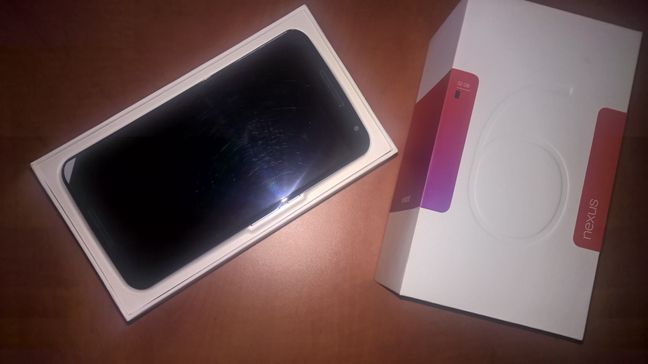
Google partners regularly with various hardware manufacturers in order to create its line of Nexus devices. From such an alliance came to life the Motorola Nexus 6 - a high-end smartphone with a clean and unaltered Android on it. It's a big smartphone with a large 6 inch display, powerful hardware inside and with lots of interesting promises for the end user. We've had the Nexus 6 in our hands for quite a while now and we used it daily as our main communication device. Of course, we also ran lots of tests and benchmarks and we put it to a level of stress that not many people would. If you're an Android fan and you want to experience a clean Android experience, just as it was created and intended by Google, than you should read this review. By the time you will finish reading, you'll know if the Motorola Nexus 6 is the smartphone to buy this holiday season:
Hardware specifications & packaging
The Motorola Nexus 6 comes in a white cardboard box with a simple and minimalist design. On its top side stands engraved a large six figure and nothing else.
The bottom and the sides of the box are held together by a red sticker on which is printed an image of the Nexus 6 smartphone, while on one of the smaller ends of the box you'll find some technical information: the smartphone's name, IMEI, model number and so on.
The first thing you'll see when you open the box is the Motorola Nexus 6 itself.
Underneath the smartphone, there's a small red box in which you'll find a quick start guide, the Safety + Warranty booklet and a small pin for removing the SIM card. Tucked under the small red box sits the charger and its detachable USB cable.
The Motorola Nexus 6 is available in only two color variations: Midnight Blue and Cloud White.
It features an impressive 5.96 inches AMOLED display that offers a QHD resolution of 1440 x 2560 pixels at 493 ppi pixel density. The smartphone is powered by a powerful quad-core Krait processor running at 2.70 GHz and an Adreno 420 graphic processing unit. Motorola has been generous when it comes to memory too: the Nexus 6 offers 3GB of RAM and 32GB or 64GB of internal storage space, depending on the model you buy. You'll have to choose wisely the variant you buy, because the Nexus 6 doesn't have an SD card slot, so you won't be able to expand the storage capacity. The autonomy of the Motorola Nexus 6 is handled by a non-removable lithium-polymer 3220mAh battery.
The rear camera uses a 13 megapixels image sensor from Sony, capable of taking pictures at resolutions of up to 4128 x 3096 pixels, with autofocus and optical image stabilization. The camera is also helped by a dual-LED flash for low light pictures and it can also take pictures with HDR. The main camera can also record videos at 2160p@30fps. The Nexus 6 has a front camera built-in too, but this one has only 2MP and it's obvious that it's destined only for video chat apps and not for high-quality selfies.
In terms of connectivity, the Motorola Nexus 6 uses a nano-SIM and can connect to GSM/GPRS/EDGE, UMTS/HSPA+ and 4G LTE mobile networks. It also offers a microUSB v2.0 port, Bluetooth v4.1 with NFC and dual-band wireless support for the 802.11 a/b/g/n and 802.11ac networking standards. This means that you will be able to connect to both 2.4GHz and 5GHz wireless networks and enjoy fast wireless network connections.
The Motorola Nexus 6 is undoubtedly a phablet, with a large 6 inch screen. This also means a big body: the Nexus 6 has a size of 159.3 x 83 x 10.1 mm (6.27 x 3.27 x 0.40 inches) and weight of 184 grams (6.49 oz).
If you'd like to see more details about the features and the detailed hardware specifications of this smartphone, you should browse its official webpage: Motorola Nexus 6 - Specifications.
The Motorola Nexus 6 packs some powerful hardware. There aren't that many smartphones with QHD screens or 3GB of RAM memory. Just by reading its hardware specs, you know that you're looking at a high-end device.
Design & build quality
The first thing that catches your attention at the Motorola Nexus 6 is its size. The details we shared earlier about how large and heavy the Nexus 6 is are useful but you won't really get it until you actually see and hold the device. We feel the need to say this from the start: this is not a smartphone for everyone. If you have small hands or if you're not ready to use your smartphone with two hands, the Nexus 6 is not for you.
For this smartphone, Motorola and Google went for a simple and functional design. The front side of the smartphone is dominated by the large screen. The bezels are narrow and you'll see no hardware buttons here, as the Motorola Nexus 6 chooses to use software buttons that appear on its display. Also talking about the display, we must say that it looks stunning, with vibrant colors, very good contrast and high brightness levels that make it easy to see the screen even in direct sunlight. The very large resolution and high pixel density it offers couldn't have led to any other result. The Nexus 6 does very well at representing colors, but while blacks are true blacks, whites seem to suffer from a slight yellowish tint. However, this is not upsetting in any way.
Other than the display, there is only one other thing that captures your view on the smartphone's front: the two speaker grilles . There's one at the top and one at the bottom of the screen.
Even if the Nexus 6 is one of the largest smartphones we've seen, it still feels good to hold in your hands. A reason for this is the design and the materials used for creating the back side. Motorola used high quality polycarbonate that's nice to touch, smooth and grippy. The back of the smartphone is also slightly curved to the edges, thus giving you the sensation that the Nexus 6 is thinner than it actually is. In terms of branding, the back side of this smartphone is dominated by the nexus name and the M logo from Motorola. On the top side you'll also find the rear camera encircled by its ring dual-LED flash. The picture below cannot tell you how great the feeling you get is when touching the back of this smartphone. It's silky, like a cat's fur... 🙂
Moving on to the edges of the Nexus 6, Motorola used aluminum for creating them. This helps give the smartphone robustness and also helps against unfortunate hits and bumps your smartphone could suffer.
The top rim of the Nexus 6 houses a 3.5mm audio jack and the nano-SIM slot, which can be opened with the pin supplied in the smartphone's package.
The left edge is unused and flows smoothly from one end to the other. On the bottom rim you get only one connector: the micro-USB port used for charging and connecting your smartphone to a computer.
And on the right side of the Nexus 6 you'll find the power button and the volume rocker. The power button is placed above of the volume buttons and, to make it easier for you to find it without looking at it, it has a rough texture, while the volume rocker is smooth and plain.
Its dimensions make the Nexus 6 a good choice only for people with large hands and for those who are prepared to use it two-handedly most of the time. However, after we used the Motorola Nexus 6 for a few weeks, we must say that this is a smartphone you get used to. Its screen is great when it comes to typing, browsing the Web or watching movies.
The smartphone experience on the Motorola Nexus 6
A top tier smartphone like Motorola Nexus 6 couldn't have been other than great when it comes to phone calls. No matter whom we've talked to over the phone, our conversations on the Nexus 6 were always crisp and clear. Even in the most noisiest of environments, we had no problems in understanding or being understood by the people we talked to.
The signal reception is also good. We used the Motorola Nexus 6 in a geographical area where 4G is available, but the network signal isn't stable at all. The reason is most likely the fact that we live in a mountain area and our mobile network operator doesn't have the greatest radio towers. However, the Nexus 6 jumped from 3G to 4G and backwards without any "hiccups".
It's worth noting that the Motorola Nexus 6 uses a nano-SIM card that you can plug in by opening its tray from the top edge of the smartphone. To do that, you'll need to use the pin supplied inside the package. Insert the pin inside the nano-SIM tray pinhole and gently press inwards. This will bring out the SIM tray.
In terms of audio quality when playing music or watching movies, the Motorola Nexus 6 does well too. The smartphone has two loudspeakers built-in that provide you with stereo sound that's clear and loud. We didn't notice any distortions even when using the highest volume setting. We also appreciate the fact that Motorola placed the two loudspeakers on the front of the device, instead of on its rear, as many manufacturers choose. This way, the sound coming out of the loudspeakers is targeted directly at you instead of the surface on which you place your Nexus 6.
However, if you want higher audio fidelity, we recommend that you use a pair of headphones. We found the Nexus 6 to offer a much better sound this way, even if we used a standard aftermarket pair of headphones. Unfortunately, Motorola didn't include any headphones with the Nexus 6.
As for the operating system, the Nexus 6 is a device created by Motorola and Google which means that you get the clean Android experience, as it was meant by Google. There are no added features or apps coming from Motorola - it's just clean Android. The Nexus 6 comes with Android 5.0 Lollipop pre-installed, but you can upgrade it to the latest Android flavor: Android 6 Marshmallow.
The Nexus 6 is powered by a non-removable lithium-polymer 3220mAh battery, which does its job as specified by Motorola. That means it will last you for a day in normal usage. However, if you use your smartphone extensively, it won't last you that long. For the supersized screen, a larger battery might have been better.
The Motorola Nexus 6 offers a good smartphone experience. Regardless of the conditions we were in, our phone conversations were clear and loud, and the mobile network signal was strong enough to not cause any interruptions, even though we live in a mountain area where the 4G connection is quite unstable. The audio quality is also good, the two front facing speakers being quite powerful. However, if you want better sound fidelity, we strongly recommend that you use a pair of headphones.


 04.12.2015
04.12.2015 
















